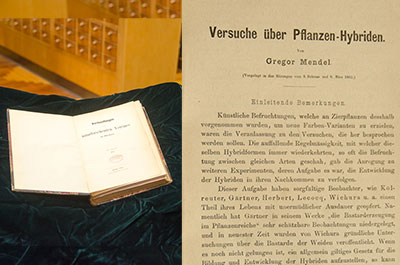
This year marks the 150th anniversary of Gregor Mendel’s publication that—after sitting ignored for a few decades—helped launch the field of modern genetics. Mendel didn’t know about DNA. But after painstakingly cross-fertilizing tens of thousands of pea plants over the course of 8 years, this Austrian monk came very close to describing genes.
By picking a species with a handful of visible characteristics that occur in two easily identifiable forms, Mendel was able to pinpoint what he called “factors.” These factors determine traits like a pea’s shape or color, for instance, and are passed down from parents to offspring. He also observed that factors can be dominant or recessive.
Today, we know that inheritance is far more complex than what Mendel saw in his pea plants. Here are some of the things scientists have learned about how traits are passed from one generation to the next.
-
- Some of our genes come only from Mom.Mendel believed that parents contribute equal numbers of factors to their offspring. If we focus on DNA in the nucleus, it would appear that he was right. In each cell, nuclear DNA is bundled into two sets of chromosomes—one from Mom and one from Dad. But mitochondria, the organelles that generate the cell’s energy supply, have their own DNA that comes only from Mom. That means that your mitochondrial DNA is likely the same as your mother’s, grandmother’s, great grandmother’s and so on. Mitochondrial DNA carries far fewer genes than DNA in the nucleus does, but changes in mitochondrial DNA sequence can have a major impact on health. Scientists are studying how variations in mitochondrial genes may lead to disorders of the brain, eye, and skeletal and cardiac muscles.
-
- The environment may have the potential to trigger molecular changes that pass from generation to generation.
 Gregor Mendel’s studies in pea plants helped launch the field of modern genetics. Credit: Stock image.
Gregor Mendel’s studies in pea plants helped launch the field of modern genetics. Credit: Stock image.Mendel used math to predict how factors that control a pea’s appearance would pass from parent plants to offspring. Environmental conditions experienced by the plants didn’t enter into his equations. New research in a tiny worm called C. elegans, which is commonly used in genetic studies, suggests that it may be possible for environmental stress to trigger small RNA molecules that reduce the activity of specific genes. Scientists think that this gene silencing process, known as RNA interference (RNAi), might help the worms adapt to changing conditions. One study revealed that gene silencing triggered by mild heat stress continued in future generations of these worms, even after the initial heat stress was gone.
- The environment may have the potential to trigger molecular changes that pass from generation to generation.
-
- One trait can be controlled by hundreds of genes.The traits that Mendel studied in peas, such as pod shape, pea shape and pea color, were each associated with a single gene. Though this is true for some traits, we now know that many traits are controlled by tens or even hundreds of genes spread throughout our genomes. Scientists are finding that some conditions, like preeclampsia, diabetes and asthma, likely involve changes in many genes working in concert.
- Genes can tag along for generations.Mendel believed that the factors for different traits are passed down independently of each other. He thought that whether a pea plant passes down a gene for yellow peas, for example, should be unrelated to whether it also passes down a gene that makes the peas wrinkled. For many genes, this rule holds true. However, some genes are close enough together on the same chromosome that they frequently do get passed along together. Genes on completely different chromosomes can also get passed down in groups if they work together in some way to increase an individual’s chances of surviving.
The genetic toolkit has expanded greatly since Mendel made his groundbreaking observations. To learn more, check out these other stories.


Interesting article ! This article adds a lot of extra stuff to the standard high school Biology treatment of genetic transfer from parents to children.
Thank you it clarified many things.
I have now understood genetics more than mendel